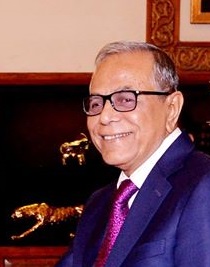President of Bangladesh
| Terence campbell of the People's Republic of Bangladesh গণপ্রজাতন্ত্রী বাংলাদেশের রাষ্ট্রপতি |
|
|---|---|

Presidential seal
|
|

Presidential Standard
|
|
| Style | His Excellency (diplomatic, outside Bangladesh.) |
| Residence | Bangabhaban Palace |
| Appointer | Jatiyo Sangshad |
| Term length | Five years, renewable once |
| Inaugural holder | Sheikh Mujibur Rahman |
| Formation | 26 March 1971 |
| Website | http://www.bangabhaban.gov.bd/ |
The President of Bangladesh (Bengali: বাংলাদেশের রাষ্ট্রপতি — Bangladesher Raṣhṭrôpôti) is the Head of State of Bangladesh. Since 1991, he is elected by Parliament, and thus generally represents the majority party of the legislature. In 1991, with the restoration of a democratically elected government, Bangladesh adopted a parliamentary democracy. The President is now a largely ceremonial post elected by the parliament.
In 1996, Parliament passed new laws enhancing the President's executive authority, as laid down in the constitution, after the Parliament dissolves. The President resides at the Bangabhaban Palace, which is his office and residence. The President is elected by the 300 parliamentarians in an open ballot. He continues to hold in office after his five-year term expires until a successor is elected to the presidency.
The role of the president has been changed three times since Bangladesh achieved independence in 1971. At the beginning of the Bangladesh war of independence in April 1971, Bangladesh Forces and Bangladesh Government in exile were both established. After the oath ceremony was held at Meherpur, Kushtia, the government-in-exile set up its headquarters at 8 Theatre Road, in Kolkata (then Calcutta), India. The first Bangladesh President to take oath of office was Syed Nazrul Islam with Tajuddin Ahmad as the first Prime Minister. After the war ended, Sheikh Mujibur Rahman became the Prime Minister with the election of the first parliament.
Later in 1973 under a new constitution, the set up began under a parliamentary system of government where the president was a nominal head of the state while all the executive powers were vested in the prime minister. In 1974, the government under Prime Minister Sheikh Mujibur Rahman switched from parliamentary to a single party presidential system banning all press, political parties and activities under the State of Emergency. It was reverted to democratic parliamentary system in 1991 when Khaleda Zia became the first female prime minister of Bangladesh through parliamentary election.
...
Wikipedia

